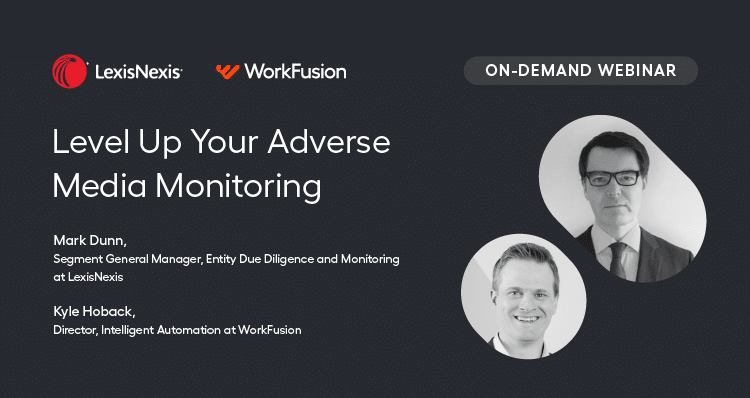WorkFusion and LexisNexis recently presented a webinar: “Level Up Your Adverse Media Monitoring.” During this event, Mark Dunn, Segment General Manager for Entity Due Diligence and Monitoring at Nexis Solutions, and Kyle Hoback, Director, Intelligent Automation at WorkFusion, provided a comprehensive overview of AI’s role in an optimized Adverse Media Monitoring solution. Afterward, attendees were able to address their questions to the speakers.
For those who could not join us live, or who might appreciate a recap, read on for highlights of the presentation.
Shift in risk focus
Over a decade ago, Dunn says, anti-money laundering was the key area of risk mitigation for banking, financial services, and insurance enterprises. But now we are recognizing a whole range of regulatory risks extend beyond money laundering: regulatory, financial, strategic, and reputational.
As these risks intensify every year, companies must meet the technological requirements to mitigate them.


Technology is now very much the enabler to help companies stay on top of the volumes of due diligence, screening and refresh required…[and] the higher costs around manual resources in large teams of due diligence analysts. Technology can be used to direct value at the right places in the organization. So, adverse media screening is a crucial area where technology can certainly help improve and mitigate risk, manage cost, and drive efficiency.


Adverse news monitoring pitfalls
According to Hoback, there are four mistakes that businesses make in their approach to negative news monitoring.
- “Just outsource it”: Expensive third parties, plus inevitable time lags, can complicate execution.
- “Just Google it”: Google (or other search engines) may be sufficient for consumer uses, but the best and most relevant content is not available to these search engines, plus may return false positives and require extensive manual review.
- “It’s only a report”: Manual creation of narrative reports with screenshots and keystrokes can lead to errors.
- “It’s just rules”: Regulatory compliance requires more than RPA can handle, more than sentiment analysis – even more than a single machine learning model.


If you’re applying AI to this process, it needs governance and explainability. It can’t be a black box where you throw data into it and get that ‘yes’ or ‘no.’ So, it’s not just having all those tools, including AI; it’s making sure you have explainability and governance included.


A better way
Dunn presents LexisNexis’ dedicated solution, and how it works with the WorkFusion platform:


We offer a wide range of flexible APIs both for search and retrieve [functions] and for hosted scenarios. When combined, the Nexis Solutions APIs and the WorkFusion application bring significant time and benefit efficiencies to an Adverse Media Monitoring process. So, you can realize up to 80% to 90% off the time it takes to search information, analyze and assess the data, and be able to move on to your next inquiry.”


Benefits of an AI-driven approach
Hoback reviews the advantages of using AI for Adverse Media Monitoring:
- Speed: AI expedites onboarding and streamlines refresh and other areas where it’s applied. There’s no need to wait to open an account and then, a couple of weeks later, screen for adverse media and identify unreliable customers.
- Accuracy: With AI in place, analysts do only a few minutes of work, and they don’t have to create a report. Less human intervention means fewer opportunities to introduce errors.
- Coverage: There is no need to hire 100 people to spend all day Googling the news. With AI-driven Intelligent Automation applied, it’s possible to achieve the same level of coverage with 10 people.
Efficient use of human resources
Dunn wraps up with key takeaways about AI and Adverse Media Monitoring, including the use of human resources:


Look at your due diligence analysts and make sure their skill sets are being directed where they are most valuable. That’s looking at the output, advising the business, coming to risk decisions — not getting involved in this very repetitive, prescriptive process of reviewing lots of things and having to work their way through that manually. You can save enormous time, boost efficiency, and drive good cost savings by using content and technology as an enabler.


This article covers only a few highlights of the conversation. We recommend watching the full webinar from our library of on-demand webinars. Please contact us to learn more about how our innovative solutions can meet your needs.




























